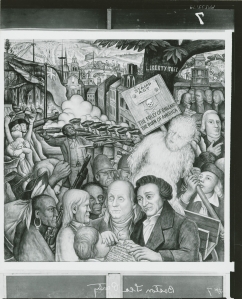All praise to the humble pamphlet, upon which *may* rest the ideological origins of the American Revolution. Frequently buried by history as loose “Bundells of Pamphlets in quarto,” it’s a genre that almost shouldn’t be. Printed on flimsy paper and easily battered by salt spray or avid readers, the popular pamphlet became a clutch genre for British and American revolutionaries to send ideas around the Atlantic World. These publications, along with newsbooks, hardened into the “paper bullets,” that, according to scholar Joad Raymond, flew on and off the page in early modern England’s press.
Even as the genre evolved into weekly newspapers, he writes, “readers recognized the rules of the form.” Pamphlet culture, a dynamic arena for anonymous critics to take an eloquent swipe at matters of church and state, quickly blossomed abroad. Unbound and unfettered, pamphlets seeded colonists with a new political consciousness. Whether 10 pages or 50, these slim booklets amplified republican politics and revolutionary prose. Pamphlets, as Robert G. Parkinson observes, became the “lifeblood” of the American Revolution. “They instructed the colonial public that political and personal liberty were in jeopardy because British imperial reformers sought to strip them of their natural rights, especially the right to consent to a government that could hear and understand them,” he writes. Today, let’s look at that instructional aspect of pamphlet culture, and how Bernard Bailyn’s interpretation of revolutionary tracts has reshaped what we do in public history. Continue reading





 In a certain village of vast early America, whose name I do not recall, a book fell open. Then another. And another. By 1860, many generations’ worth of American readers had imbibed the two-volume work of Spain’s early modern master, Miguel de
In a certain village of vast early America, whose name I do not recall, a book fell open. Then another. And another. By 1860, many generations’ worth of American readers had imbibed the two-volume work of Spain’s early modern master, Miguel de 



